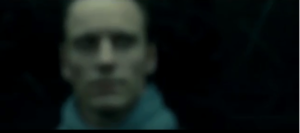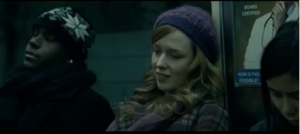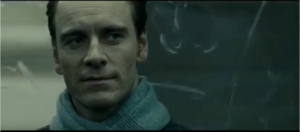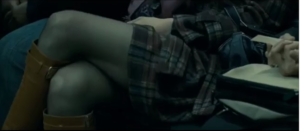For this exercise, the Kuleshov/Mosjukhin experiment is recreated to demonstrate the Kuleshov Effect. One of the interesting things about filming the face of an actor keeping a straight face, is whether this is in fact how the original experiment was conducted or whether the actor had an ‘ambiguous’ expression on their face. At the end of this blog entry I have summarized some research that was done by Steve Prince and Wayne E. Hensley at Virginia Polytechnic Institute and State University in 1992 on the Kuleshov Effect. The reason I started to look for any research that had been done was because I struggled to detect change in my actors’ face, even with the different combinations. I was aware that I reacted to the footballer being kind to the younger players and the warmth of seeing the bunny, but I was also aware that I was superimposing my reactions. My actor looked unimpressed no matter what I combined his image with, which I found rather disturbing.
Here is the experiment:
Steve Mc Queen’s film Shame has a scene in it that is a typical example of the Kuleshov Effect. In most explanations of the Kuleshov Effect, you see three or more different ‘objects or people’ that the expressionless person is looking at. However, in practice, this effect is typically used with one expressionless person and one other subject/item.
Shame is a story about a man called Brandon, whose life is being destroyed by his addiction to sex. He lives a very respectable public life, however at night he goes out looking to find woman (or men if necessary) to have sex with. The scene is Shame that uses the Kuleshov Effect is referred to as the’ subway scene’. Brandon is out looking for someone and spots a girl in the underground sitting diagonally across from him. The first shot of Brandon is a close up with him occupying the left third of the frame. His face is blurred and the shadows on his face make him look slight grotesque and predatory – an indicator of the behaviour that he can’t control. We then see a shot of the woman looking at him – implying that she is prey.


Brandon’s face comes into focus and he continues to stares at the woman, his expression does not change throughout this scene, which lasts a few minutes. At first, the woman smiles and very subtly flirts. When Brandon continues to stare with no reaction, the woman becomes uncomfortable and crosses her legs, away from Brandon, effectively rejecting his stares. However, Brandon continues to stare. This gives the audience the feeling that Brandon is a sinister and dangerous character. Through this sequence, Brandon’s expression does not change, but by cutting to the woman and how she is behaving, we can infer a lot about Brandon’s intentions and emotions.


I had a look at other students recreations of this experiment:
For the above video from KAFKAsFriend film blog, I found it difficult to follow and I think it was because the shot of the actor with a neutral face was quite short whereas the shot that followed was long and contained a lot of detail. This was further confused by the actor also playing the role in the following shot – he was looking at himself? While I like the idea of seeing oneself, it did make it difficult to see that it was a repeat of the experiment.
Another factor that played a part for me is that the actor and then the subsequent shot had very different lighting and backgrounds, the first being very light and the second darker with lots of shadows. It made it difficult to believe that the actor was able to see the action as he appeared to be in a very different location.
I then had a look at this one from Helen Rosemeir:
This experiment was far more effective. I think the reason that this one works is that the actor, although keeping a neutral expression, definitely appears to be looking at the items/people in the alternating shots. I also find that the more dramatic shots seem to be more effective and I began wondering if I was reacting to those images and not necessarily the expression on the actors face.
Research that has been carried out on the Kuleshov Effect
Steven Prince and Wayne E. Hensley published a paper in the Cinema Journal in 1992, where they explained that in the absence of the original recording performed by Mozhukin or any description of how Kuleshov went about his experiment (e.g. what were the audience told before seeing the sequence, what procedures were used), it is not possible to validate the conclusions that Kuleshov reached. In their view, the Kuleshov effect has simply become part of film studies culture and accepted as fact.
Prince and Hensley set out to replicate the Kuleshov Effect using modern research paradigms to validate Kuelshov’s theory. They made a similar sequence to the original; actor’s face followed by soup, coffin and child. They used 137 under-graduate students from an American university. They made sure that none of the students were film students who would recognise the experiment and respond accordingly. Students were asked to look at only one of the coupled shots and then evaluate the performance of the actor in terms of the emotion expressed.
The result of this experiment showed that the audience did not experience the Kuleshov Effect. The vast majority reported that they saw no change in the emotion of the actor. Prince and Hensley have tried various explanations to account for why this might be the case. The most plausible of these is that since the original footage has been lost, we are not in a position to know if the ‘Kuleshov’s montage was more complexly constructed than has been reported’(Prince 1992: 70) It is possible that the actors’ express was not ‘neutral’ but rather ‘ambiguous’ or there may have been ‘associational cues (e.g. camera movement toward the actor, and/or the objects, ambiguous changes of display on the actors face, use of music)’ (Prince 1992: 68) that were providing the audience with more information than what is conventionally thought to be the case.
Prince and Hensley concluded their study by saying that they could not conclusively verify the correctness of Kuleshov’s claim since they are not able to replicate precisely how his experiment was carried out. They nonetheless acknowledge that this experiment did enable later editors to experiment with different ways of editing.
Filmography/Bibliography:
Shame [feature film, DVD] Dir. Steve McQueen. See saw Films, Film4, UK Film Council.UK, 2011, 101 min.
Prince, S and Hensley, W. (1992) Cinema Journal, Vol 31, No 2 (Winter 1992), pp 59-75.
